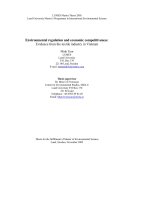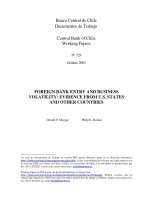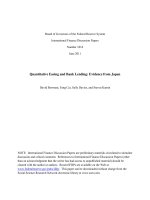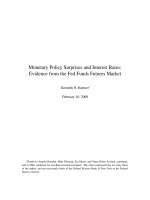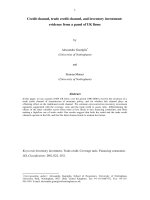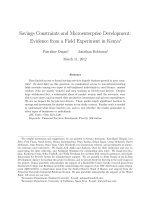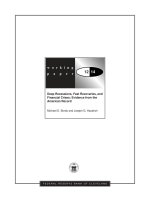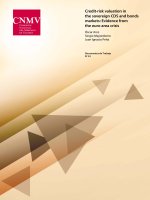Auditing quality, investor sentiment and earnings response - evidence from the Chinese a share market
Bạn đang xem bản rút gọn của tài liệu. Xem và tải ngay bản đầy đủ của tài liệu tại đây (313.22 KB, 13 trang )
Accounting and Finance Research
Vol. 7, No. 2; 2018
Auditing Quality, Investor Sentiment and Earnings Response
---Evidence from the Chinese A-Share Market
Ling Zhang1, Chao Ge2 & Wun-Hong Su1
1
Shantou University, China
2
University of International Business and Economics
Correspondence: Wun-Hong Su, Shantou University, China
Received: January 12, 2018
Accepted: February 8, 2018
Online Published: February 9, 2018
doi:10.5430/afr.v7n2p110
URL: />
The author acknowledges the funding from Humanities and Social Sciences research project (award number:
11YJC790274) of Ministry of Education.
Abstract
The purpose of this study is to investigate whether auditing quality mitigates the impact of the investor’s sentiment
on share market response to earnings news. Auditing quality involves auditor reputation quality and auditor implicit
quality. The high-quality of auditing work can not only enhance the investors’ confidence, but also reduce the
transaction costs. Using 12,345 observations from the Chinese A-share market over the period 2007 to 2014, the
empirical results demonstrate that the different auditing quality signals generate the distinct influences on the
investors. Specifically: (1) there is an insignificant relation between auditor reputation quality and the influence of
investor sentiment on share market response to earning news; (2) there is a significant association between auditor
implicit quality and the influence of investor sentiment on share market response to earning news.
Keywords: auditing quality, investor sentiment, earnings response, information asymmetry, signaling theory
1. Introduction
The behavioral finance theory illustrates that the over demand of the irrational investors results in the mispricing in
share market. Baker and Wurgle (2006) document that the investors tend to invest the specific shares such as small
shares, young shares, high volatility shares, unprofitable shares, non-dividend-paying shares, extreme growth shares,
and distressed shares. Their empirical results indicate that the higher beginning-of-period proxies for investor
sentiment the lower subsequent returns these categories of shares. The investor sentiment, broadly defined, plays a
crucial role in the cross-section of share prices, realized returns, or expected returns. Therefore, the investor
sentiment has a significant impact on share market response to earnings news.
Chinese A-share market is an emerging economy with a unique investing and governance environment. A variety of
governance mechanisms such as auditors have been introduced into the Chinese share market from the developed
countries to prevent minority investors from economic losses. A-share market is driven by market rumor and
individual investor sentiment. Most investors in A-share market is in possession of little financial information and
frequently follow the investing strategies of others. According, any unexpected news appears to contribute to the
volatility of A-share market in China.
Using data on Chinese A-share listed firms from 2007 to 2011 Chang and Chen (2014) investigate whether internal
control mitigates the impact of investor sentiment on share market response to earnings news.Their empirical
findings are that for firms with low internal control quality, share market responses to earnings news are more likely
to be influenced by investor sentiment. The high (low) investor sentiment increases with earnings response
coefficients of good (bad) news. In contrast, for listed firms with high internal control quality,high (low) investor
sentiment decreases with earnings response coefficients of good (bad) news. These findings seem to suggest that
high internal control quality can mitigate the effect of investor sentiment on earnings response coefficients. There are
more evident in small firms and non-state owned firms.
The extant studies (e.g. Mian and Sankaraguruswamy 2008; Yao et al. 2015) view the external audit as the effective
Published by Sciedu Press
110
ISSN 1927-5986
E-ISSN 1927-5994
Accounting and Finance Research
Vol. 7, No. 2; 2018
signal to mitigate asymmetric information between principals and agents. DeAngelo (1981) defines the auditing
quality as the auditor’s finding and reporting financial statements with material misstatement or omission of joint
probability. Chen et al. (2009) mention that auditing quality includes two dimensions: the market perception of
auditing quality and the auditor implicit quality. The former means the auditor reputation while the latter refers to the
“supervision strength” and the “information quality” by the auditors. Fair auditing works are viewed as a signal to
ease the information asymmetry between investors and firms. The influences of the investor sentiment on share
market response to earnings news can be restrained by the good reputation of the auditors and the auditor implicit
quality. Accordingly, this study aims to investigate whether auditing quality mitigates the impact of the investor’s
sentiment on share market response to earnings news in A-share market.
The remainder of the paper is organized as follows. In the following section, an overview of the auditing quality and
prior research into accounting for investor sentiment and earning response are introduced. From this, hypotheses are
developed in the third section. In Section 4 the research design is described and includes the various measures of the
auditing quality and control variables used in the analyses. Section 5 provides some preliminary descriptive results
and sets out the main results of the analysis regarding auditing quality and the influence of investor sentiment on
share market response to earning news, together with robustness tests. Finally, the conclusions are presented in
Section 6.
2. Related Literature
2.1 Auditing Quality
The existing studies find little difference between auditing quality and auditing independence. The high degree of
auditing independence implies high auditing quality (DeAngelo 1981b). Auditing quality consists of market
perception of auditing quality and the implicit auditing quality. The market perception of auditing quality is
frequently viewed as being equal to the auditor implicit quality, while good reputation of auditors is regarded as an
assurance to the high quality of accounting information in most developed capital markets. The auditors with good
reputations are likely to provide high quality of financial information for litigation risks and reputation costs. Lin and
Wang (2013) indicate that the auditing firms with higher reputation take higher risk and litigation costs. Lin and
Wang provide the evidence of a positive association between auditor reputation and information quality for the
international auditing firms. Guo and Huang (2015) document that there is a significant positive relation between
auditor reputation and information quality over the period from 2007 to 2012.
However, Guo (2007) finds that the higher reputation of the auditing firms decreases with the implicit auditing
quality during the year of 2007 to 2009 in the Chinese share market. Liu (2007) demonstrates that the international
auditing firms enjoy the lower litigation costs and supervision costs. As the result, the higher the reputation of
auditing firms leads to a lower information quality. Moreover, Liu and Liu (2007) regard the implicit auditing quality
as both auditing opinion and the discretionary accruals. Gopal (2003) agrees the measure of the auditing quality as
the accuracy of financial information which can be correctly reflected and predicted for the future cash flow and
earnings.
Nevertheless, Carcello et al. (2014) critically pointed out that the traditional measures for the auditing independence
(or the auditing quality) appear to lots of limitations that have no support the proposed relation between non-audit
services and auditor independence. Using a new measure of goodwill impairments as the implicit auditing quality
their empirical results reveal that the level of non-audit fees for a client is significantly and negatively related to the
likelihood of recognizing the goodwill impairment in a setting where goodwill is impaired. The goodwill impairment
costs the auditing firms more than the goodwill amortization. The goodwill impairment decreases with the share
prices. The auditing firms likely manipulate the goodwill impairment for the self-interest or the intimidation by the
clients. As the result, the goodwill impairment is an appropriate proxy for the auditing independence (or the auditing
quality). Moreover, Wu and Liu (2015) demonstrate that there is a negative relation between the goodwill
impairment and the share prices in the Chinese share market while Hsu and Hun (2011) indicate that the auditing
firms with the good reputation tend to recognize the greater amount of goodwill impairment.
2.2 Investor Sentiment
The behavioral finance theory illustrates that investor sentiment has the greatest impact on asset prices. Stein (1996)
argues that the investor sentiment is a manifestation of the irrationality. The irrational psychology leads the investors
to overestimate or underestimate the share prices. Baker and Wurgler (2006) define the investor sentiment as the
propensity for speculation and investigate the impact of investor sentiment on the cross-section of share returns in the
Chinese A-share market. Baker and Wurgler mention that the arbitrage and the investor sentiment result in the
Published by Sciedu Press
111
ISSN 1927-5986
E-ISSN 1927-5994
Accounting and Finance Research
Vol. 7, No. 2; 2018
mispricing in share market. The arbitrage causes the mispricing for firm share with the specific characteristics such
as the volatility while the investor sentiment has the significant impact on the pricing behavior.
The different investor sentiment leads the investor to invest the firms with the diverse characteristics such as the
newly listed firms, the young firms, the high growth firms. In the study of Baker and Wurgler (2006) the empirical
results reveal that the high investor sentiment earns the relatively lower subsequent return. When investor sentiment
is high, shares of extreme growth, distressed, high-price, unprofitable and low book-market ratio earn the relatively
lower returns and vice versa. The investors with high sentiment pay too much for the share with those specific
characteristics. In addition, Baker and Wurgler (2006) provide the evidence of an insignificant relation between the
cross-section effect of investor sentiment and its characteristic portfolio return for the capitalization, volatility and
institutional ownership.
Cornell et al. (2014) investigate whether the firms with accounting information that are inherently difficult to value
can mitigate sentiment-related mispricing. Their findings suggest that the sentiment-related mispricing decreases
with the high quality of accounting information. They conclude that when investor sentiment is high the analysts give
more favorable suggestions for firms with specific characteristics such as being more difficult to value,
overestimated and negative subsequent abnormal share returns.
Moreover, Aissia (2016) examines whether home and foreign investor sentiment affect share returns. Using the total
investor sentiment index of Baker and Wurgler (2006) and based on data of all the firms of the CAC All Tradable
indexes over the period 2003 and 2013, Aissia finds that foreign and home sentiment are significantly related with
the contrarian predictors of share returns. This finding provides evidence that home bias of share is an important
component of investor sentiment. The results of Aissia (2016) are robust to the adoption of different measures of
total investor sentiment.
2.3 Earning Response
Easton and Zmijewski (1989) define earnings response coefficient as the estimated relation between abnormal share
returns and new information of accounting earnings announcements. Beaver et al. (1979) illustrate that the
association between share prices and accounting earnings resulted from the different response on the same shares.
Ball and Brown (1968) and Beaver (1968) are the first to investigate share market response to earning news. Using
income numbers for 1946 through 1966 obtained from Standard and Poor's Compustat Ball and Brown (1968) finds
that there is a significant association between accounting return and share market return. The useful information
content of abnormal income can be essentially conveyed to the capital market and the share market typically has
reacted in the same direction. Based upon a sample of annual earnings announcement released by 143 firms during
the years 1961 through 1965 Beaver (1968) indicates that the erratic fluctuation of share returns and share turnover
are associated with the reported earnings. This finding suggests that earnings reports involve information content.
Following Baker and Wurgler (2006), some prior studies (e.g. Mian and Sankaraguruswamy 2008; Yao et al. 2015)
focus on the relation between the investor sentiment and the share market response to earning news. Jiang and Wang
(2010) demonstrate that the investor sentiment has the significant positive impact on the share price. The investor’s
sentiment increases with the unexpected news. Mian and Sankaraguruswamy (2008), Yao et al. (2015), Jiang and
Wang (2010) report that the investor sentiment systematically affects the share price. The investors tend to pay high
prices when their sentiment is high. By contrast, the investors with low sentiment are merely willing to pay low share
prices. Consequently, the high sentiment creates the positive reactions to the unexpected news while the low
sentiment leads negative reactions to the unexpected news.
Dong et al. (2015) investigate the impact of investor sentiment on share market response to abnormal earning after
the first-time going-concern modifications. Using a sample of 581 publicly accountable firms and the event study
methodology, their results show that earnings response coefficients is featured by a significant downward trend in the
quarters following the going-concern modifications. However, when the going-concern modifications is unexpected
this finding appears to be driven by firms. Firms with high Z-scores prior to the going-concern modifications
experience an immediate and prolonged decline in earnings response coefficients over the four quarters subsequent
to the going-concern modifications while those firms with lower Z-scores have no change in earnings response
coefficients. The results are consistent with the going-concern modifications potentially signaling that the earnings
numbers generated by the firm are noisier or less persistent than was previously assumed. Their empirical finding
makes an important contribution to the going-concern literature by demonstrating the going-concern modifications
affect the pricing of earnings.
Furthermore, Hosseinia et al. (2016) aim to investigate the possible impact of earnings management incentives on the
Published by Sciedu Press
112
ISSN 1927-5986
E-ISSN 1927-5994
Accounting and Finance Research
Vol. 7, No. 2; 2018
earnings response coefficient. Using a sample of 100 listed firms in Tehran Stock Exchange over the year of 2007
through 2013 their empirical results show that there is no relation between earnings management incentives and
earnings response coefficients. Mian and Sankaraguruswamy (2012) investigate the impact of market-wide investor
sentiment on the share price sensitivity to firm-specific earnings news. Using the measure of investor sentiment by
Baker and Wurgler (2006) the empirical results reveal that higher sentiment leads to higher share price sensitivity to
good earnings news whereas lower sentiment results in higher share price sensitivity to bad earnings news. The
investor sentiment has a significant impact on the earnings news of small shares, young shares, high volatility shares,
non-dividend paying shares and shares with extremely high and low market-to-book ratios. Accordingly, the general
mispricing of shares resulted from the sentiment-driven mispricing of earnings.
3. Hypothesis Development
The high auditing quality is viewed as a signal to prevent the investors from economic losses. Jenson and Meckling
(1976) point out that there is the significant information asymmetric between managers and investors. The managers,
whose motive, by the self-interest appear to transfer shareholder wealth to selves. Chow (1982) and Randolph (1982)
implies that the investors are able to realize the self-interest of mangers and are merely willing to pay low for the
purchase of bonds and shares, leading both honest and dishonest managers have the same capital cost. The honest
mangers choose to hire the auditors with a good reputation as a signal for the investors to avoid inefficient financing
activities because of the higher risk of litigation for the high quality auditors (Balachangon and Ramakriaman 1980;
Cornell et al. 2014). Accordingly, the investors see the high quality auditors as being able to mitigate information
asymmetries.
Cornell et al. (2014) and Chang and Chen (2014) illustrate that the information asymmetry causes the impact of
investor sentiment on the share prices and earnings response. The more the information asymmetry, the more errors
the estimation of future cash flow. Previous studies (e.g. Cornell et al. 2014) also document that the auditors can
mitigate the information asymmetry. The high reputation of auditors is significantly and positively related to the high
quality of the financial reports. Auditors with good reputation can help the investors accurately evaluate market share.
The signal of the auditors with a good reputation is regarded as the reduction of the mispricing behavior and share
market response to earning news. The high auditing quality can improve the accounting information quality and
provide the investors with accurate recognition of share prices.
Chen et al. (2009) mention that auditing quality includes two dimensions: the market perception of auditing quality
and the implicit auditing quality. The former means the auditors’ reputation while the latter refers to the “supervision
strength” and the “information quality” by the auditors. The high auditing quality contributes to the high quality of
accounting information and transparent disclosure of accounting information. Fair auditing works are viewed as a
signal to ease the information asymmetry between investors and firms. The influences of the investor sentiment on
share market response to earnings news can be restrained by the good reputation of the auditors and the implicit
auditing quality. Accordingly, this is reflected in the following hypotheses:
Hypothesis 1: The auditor reputation quality can mitigate the impact of the investor sentiment on share market
response to earning news
Hypothesis 2: The implicit auditing quality can mitigate the impact of the investor sentiment on share market
response to earning news.
4. Methodology
The tests are based on the empirical framework of Cornell et al. (2014). To test hypotheses, this study utilizes the
following regression model:
𝐶𝐴𝑅𝑖𝑡 = 𝛼0 + 𝛼1 𝑈𝐸𝑢𝑝𝑖𝑡 + 𝛼2 𝑈𝐸𝑢𝑝𝑖𝑡 ∗ 𝑆𝐸𝑁𝑇𝑖𝑡 + 𝛼3 𝑈𝐸𝑑𝑜𝑤𝑛𝑖𝑡 + 𝛼4 𝑈𝐸𝑑𝑜𝑤𝑛𝑖𝑡 ∗ 𝑆𝐸𝑁𝑇𝑖𝑡 + 𝛼5 𝑆𝐼𝑍𝐸𝑖𝑡 +
𝛼6 𝑆𝑇𝐴𝑇𝐸𝑖𝑡 + ∑ 𝑌𝐸𝐴𝑅 + ∑ 𝐼𝑁𝐷𝑈𝑆𝑇𝑅𝑌 + 𝜀
(1)
To confirm the stability and consistency of the empirical results, this study conducts model (2) for a sensitivity test.
𝐶𝐴𝑅𝑖𝑡 = 𝛽0 + 𝛽1 𝑑𝑜𝑤𝑛𝑖𝑡 + 𝛽2 𝑈𝐸𝑢𝑝𝑖𝑡 + 𝛽3 𝑈𝐸𝑑𝑜𝑤𝑛𝑖𝑡 + 𝛽4 𝑆𝐸𝑁𝑇𝑖𝑡 + 𝛽5 𝑈𝐸𝑢𝑝𝑖𝑡 ∗ 𝑆𝐸𝑁𝑇𝑖𝑡 + 𝛽6 𝑈𝐸𝑑𝑜𝑤𝑛𝑖𝑡 ∗ 𝑆𝐸𝑁𝑇𝑖𝑡
+ 𝛽7 𝑆𝐼𝑍𝐸𝑖𝑡 + 𝛽8 𝑈𝐸𝑢𝑝𝑖𝑡 ∗ 𝑆𝐼𝑍𝐸𝑖𝑡 + 𝛽9 𝑈𝐸𝑑𝑜𝑤𝑛𝑖𝑡 ∗ 𝑆𝐼𝑍𝐸𝑖𝑡 + 𝛽10 𝑆𝑇𝐴𝑇𝐸𝑖𝑡 + 𝛽11 𝐿𝐸𝑉𝑖𝑡 + 𝛽12 𝐵𝑒𝑡𝑎𝑖𝑡
+ 𝛽13 𝑇𝑄𝑖𝑡 + 𝛽14 𝐷𝐴𝑖𝑡 + 𝛽15 𝐼𝑀𝑃𝑖𝑡 + 𝛽16 𝑈𝐸𝑢𝑝𝑖𝑡 ∗ 𝑆𝐼𝑍𝐸𝑖𝑡 + 𝛽17 𝑈𝐸𝑑𝑜𝑤𝑛𝑖𝑡 ∗ 𝑆𝐼𝑍𝐸𝑖𝑡 + 𝛽18 𝑈𝐸𝑢𝑝𝑖𝑡
∗ 𝑆𝐸𝑁𝑇𝑖𝑡 ∗ 𝐼𝑀𝑃𝑖𝑡 + 𝛽19 𝑈𝐸𝑑𝑜𝑤𝑛𝑖𝑡 ∗ 𝑆𝐸𝑁𝑇𝑖𝑡 ∗ 𝐼𝑀𝑃𝑖𝑡 + ∑ 𝑌𝐸𝐴𝑅 + ∑ 𝐼𝑁𝐷𝑈𝑆𝑇𝑅𝑌 + 𝜀
(2)
where a CAR denotes the cumulative abnormal return. Following Ball and Brown (1968) the normal return for the
Published by Sciedu Press
113
ISSN 1927-5986
E-ISSN 1927-5994
Accounting and Finance Research
Vol. 7, No. 2; 2018
firm i in year of t is E(𝑅𝑖𝑡 ) = 𝛼𝑖 + 𝛽𝑖 𝑅𝑚𝑡 while the abnormal return for firm i in the year of t is 𝐴𝑅𝑖𝑡 = 𝑅𝑖𝑡 −
𝐸(𝑅𝑖𝑡 ). The cumulative abnormal return for firm i during the period from t1 to t2 is CAR(𝑡1 , 𝑡2 ) = ∑𝑡2
𝑡1 𝐴𝑅𝑖𝑡 . 𝛼𝑖 is
the intercept whereas 𝛽𝑖 indicates the systematic risk for firm i. 𝑅𝑚𝑡 represents the market daily average return.
Based on Baker and Wurgler (2006) and Chang and Chen (2014) SENT indicates the investor sentiment index. The
index is composed of three concurrent proxies and their lagged proxies for each. The three proxies include
closed-end fund discount rate, new accounts in A-share market and the market turnover rate. IMP is the natural
logarithm of goodwill impairment. SIZE denotes the natural logarithm of the book value of the asset. The STATE is a
dummy control, 1, if the property right is controlled by the government, 0 otherwise. UE represents the unexpected
earnings and is △EPS/P. △EPS indicates the change earnings per share, while P denotes the opening price. Up is a
dummy variable and the good news, 1 if UE>0, 0 otherwise. Down indicates a dummy variable and the bad news, 1
if UE<0, 0 otherwise. LEV is the financial leverage ratio representing as the book value of the debt divided by the
book value of total assets. Beta is the share systematic risk in the current year. TQ is the Tobin's Q denoting as the
market value of equity plus the book value of debt and the amount of non-tradable shares divided by the book value
of the assets. DA is the absolute value of discretionary accruals sorted by each industry and each year. YEAR and
INDUSTRY are the control variables. 𝜀 indicates the random disturbance term.
The reputation information of the auditing firms is obtained from the Chinese Institute of Certified Public
Accountants (CICPA). The remaining data are gained from WIND database. All continuous variables are winsorized
at the level of 1 per cent.
5. Results
5.1 Descriptive Statistics
Table 1 reports the descriptive statistics for the various variables in the sample. The sample consists of 12,345
observations over the period from 2007 to 2014. All continuous variables are winsorised at the level of 1 per cent and
99 per cent of distribution for the mitigation of outliers. The dependent variable, cumulative abnormal returns, CAR,
is from -15.354 to 19.640. The mean and medium for cumulative abnormal returns are -0.396 and -0.831 respectively.
The investor sentiment index, SNET, ranges from -1.630 to 5.034. The mean for SENT is close to 0. The independent
variable, goodwill impairment, IMP, is from 0 to 16.323. In addition, this study divides the total sample into two
sub-groups. There are 515 observations which record goodwill impairment over the period from 2007 to 2014. The
mean and medium for IMP are 14.888 and 15.251 respectively, indicating that most IMP is on material impairment.
5.2 Multivariate Analysis
The regression results of the model (1) for the tests of auditor reputation are reported in Tables 2 through 4. In Table
2, the high reputation group indicates the Big 4 auditing firms or the top 10 Chinese auditing firms, low reputation
group otherwise. In Table 3, the high reputation group represents the Big 4 auditing firms, low reputation group
otherwise. In Table 4, without all top 10 Chinese auditing firms the high reputation group denotes the Big 4 auditing
firms, low reputation group otherwise. Table 2 primarily focuses on the chow-test for UEup*SENT and
UEdown*SENT that capture the impact of investor sentiment on earnings response coefficient between high
reputation group and low reputation group. There is a positive (or negative) association between the earnings
response of good (or bad) news and the investor sentiment. The coefficient for the interaction variables, UEup*SENT
(or UEdown*SENT) indicates the significantly positive (negative) values. This finding is consistent with Mian and
Sankaraguruswamy (2008) and seems to imply that the good news (or bad news) results in an optimistic (or a
pessimistic) valuation.
The coefficients for the interaction variables , UEup*SENT and UEdown*SENT,of the low reputation group are
-3.242 with a t-statistic of -1.01 and 3.938 with a t-statistic of 2.01 respectively. The corresponding values for the
interaction variables, UEup*SENT and UEdown*SENT, of the high reputation group, are -2.719 with a t-statistic
of-1.03 and -0.329 with a t-statistic of -0.22 respectively. Importantly, the coefficient for the interaction variable,
UEdown*SENT, is the positive significance at the level of 5 per cent for low reputation group. This finding implies
that the impact of investor sentiment is more pronounced for low reputation group.
In addition, the results of the Chow-test present a significant difference between high reputation group and low
reputation group. The t-statistic and p-value for UEdown*SENT between high reputation group and low reputation
group are 1.32, 0.188 while the corresponding values for UEup*SENT are 0.11 and 0.909 respectively. Unexpected
bad news (UEdown) and firm scales (SIZE) are significantly and positively associated with the cumulative abnormal
return, whereas unexpected good news (UEup) and Property rights (STATE) have no significant influence on the
cumulative abnormal return for both high and low reputation groups. Accordingly, the results of Table 2 seem to
Published by Sciedu Press
114
ISSN 1927-5986
E-ISSN 1927-5994
Accounting and Finance Research
Vol. 7, No. 2; 2018
suggest that the auditor reputation quality fails to mitigate the impact of the investor sentiment on share market
response to earning news and there is no support for H1.
In Table 3, the high reputation group represents the Big 4 auditing firms, low reputation group otherwise. The
coefficient for firm scales (SIZE) is significantly and positively associated with the cumulative abnormal return
(CAR) for low reputation group, but has an insignificant impact on the cumulative abnormal return (CAR) for the
high reputation group. The property rights (STATE) is insignificantly and negatively related to the cumulative
abnormal return (CAR) for a low reputation group while the property rights (STATE) have a statistically negative
influence on the cumulative abnormal return (CAR) for the high reputation group.
The coefficients for the interaction variables, UEup*SENT and UEdown*SENT, of the low reputation group, are
-3.242 with a t-statistic of -1.01 and 1.691 with a t-statistic of 1.39 respectively. The corresponding values for the
interaction variables, UEup*SENT and UEdown*SENT, of the high reputation group are 9.131 with a t-statistic of
1.71 and -4.327 with a t-statistic of -0.79 respectively. The results for Chow-test provide a significant difference
between high reputation group and low reputation group. The t-statistic and p-value for UEup*SENT between high
reputation group and low reputation group are 0.95 and 0.34 respectively. The corresponding values for
UEdown*SENT between high reputation group and low reputation group are 0.01 and 0.992 respectively. This
finding indicates that auditor reputation quality has no significant difference between low reputation group and high
reputation group. Accordingly, Table 3 provides the consistent findings with Table 2. The quality of auditor
reputation appears to fail to mitigate the impact of the investor sentiment on share market response to earning news.
This study deletes all top 10 Chinese auditing firms of sample for the high reputation group in Table 4. Accordingly,
the high reputation group denotes the Big 4 auditing firms without all top 10 Chinese auditing firms, low reputation
group otherwise. The coefficients for the interaction variables, UEup*SENT and UEdown*SENT, of the low
reputation group are -2.583 with a t-statistic of -0.80 and 3.770 with a t-statistic of 1.91 respectively. The
corresponding value of the high reputation group are 9.131 with a t-statistic of 1.71 and -4.327 with a t-statistic of
-0.79 respectively.
The results for Chow-test provide a significant difference between high reputation group and low reputation group.
The t-statistic and p-value for UEup*SENT between high reputation group and low reputation group are 0.75 and
0.454 respectively, whereas the corresponding values for UEdown*SENT between high reputation group and low
reputation group are 0.01 and 0.992 separately. This finding indicates that there is no significant association between
auditor reputation and investor sentiment.
The coefficients of UEup*SENT and UEdown*SENT between high reputation group and low reputation group are
insignificant. Accordingly, the auditor reputation fails to mitigate the impact of the investor sentiment on share
market response to earning news. Again, there is no support for H1. In addition, SIZE has a significant positive
influence on the cumulative abnormal return (CAR) for a low reputation group. In contrast, STATE is significantly
and negatively associated with the cumulative abnormal return (CAR) for high reputation groups. The findings imply
that the control variables are more sensitive to the auditor reputation.
As mentioned above prior studies (e.g., Mian and Sankaraguruswamy 2008) demonstrate that the good news (or bad
news) results in an optimistic (or a pessimistic) valuation and there is a positive (or a negative) association between
the earnings response of good news (or bad news) and the investor sentiment. Table 5 shows the regression results of
the model (1) for the test of implicit auditing quality. The coefficient for the interaction variable, UEup*SENT, is
insignificant with a t-statistic -0.45. However, the coefficient of UEdown*SENT is the positive significance at the 5
percent level (t-statistics = 2.20). The results provide support for the H2 and reveal that there is a significant
(insignificant) association between the implicit auditing quality and the earning response coefficient of bad (good)
news. Accordingly, the negatively unexpected earnings news results in the mitigation of the information asymmetry
and the earnings response coefficient while the positively unexpected earnings news leads the auditing quality signal
to dissatisfaction.
5.3 Robustness Test
As a sensitivity test, this study conducts the following tests which primarily focus on the coefficients for the
interaction
variable,
UEup*SENT*IMP and
UEdown*SENT*IMP.
The
UEup*SENT*IMP and
UEdown*SENT*IMP capture the differences of UEup*SENT and UEdown*SENT between low quality group and
high quality group. The variable for IMP is the natural logarithm of goodwill impairment. The significantly negative
(positive) coefficient for UEup*SENT*IMP (UEdown*SENT*IMP) implies that the high auditing quality indeed
mitigates the impact of investor sentiment on share market response to earnings news.
Published by Sciedu Press
115
ISSN 1927-5986
E-ISSN 1927-5994
Accounting and Finance Research
Vol. 7, No. 2; 2018
5.3.1 Goodwill Impairment at Random Tests
Carcello et al. (2014) define a sample of high independent auditors as the number of impairment over 0.5 percent of
sales income and ratio of market to book value less than one. However, the sample is limited in this study as the
result of the accounting standard of goodwill impairment implemented in China since 2007. Accordingly, this study
utilizes the model (2) for a sensitivity test. The model (2) contains more control variables with the inclusion of
financial leverage ratio (LEV), Tobin's Q (TQ), the yearly systematic risk of share market (Beta), the absolute value
of discretionary accruals (DA), property rights (STATE). The results are presented in column A of Table 6.
5.3.2 Professional Competence Tests
Consideration was given to whether the introduction of new accounting standard for goodwill impairment in China
in the year 2007 affects the auditors’ professional competence. This study, then deletes the sample firms of 2007. The
results are shown in column B of Table 4.
5.3.3 ST and ST* Share
This study removes the sample firms with ST or ST* shares for the robustness test. The sample firms with ST or ST*
shares might affect the empirical results. The sensitivity results are shown in column C of Table 6.
5.3.4 Cluster in Property Right Attribute
Based on WIND database a cluster of the property right attributes in this study consists of the central state-owned
firms, the local state-owned firms, the collectively-owned firms, the private firms, the public firms, the
foreign-funded firms and others. The robustness results are presented in column D of Table 6.
5.3.5 Another Measure of Implicit Quality
Carcello et al. (2014) point out that the proxy variables for the auditing quality appear to include the counterfactual
observations. This study re-defines the natural logarithm of goodwill impairment as 0 if the auditors give a “clear”
opinion and 1 otherwise. The robustness results are shown in column E of Table 6. The coefficient for
UEdown*SENT*IMP is negative significance at the 1 per cent level. The results seem to suggest that the negatively
unexpected earnings news results in the information asymmetry. In addition, consistent with prior studies (e.g. Dong
et al., 2015 and Wang, 2014) the finding indicates that the “unclear” opinion given by the auditor’s results in the
information asymmetry.
Moreover, the coefficient for UEdown*SENT*IMP is significant in all sensitivity tests, whereas the coefficient of
UEup*SENT*IMP is insignificant in Table 6. The coefficient of UEdown*SENT*IMP is 0.755 (t=2.32) in column A
while the coefficient estimate for UEdown*SENT*IMP in column B is 0.751 (t=2.36). The coefficients of
UEdown*SENT*IMP remain the positive value of 0.685 with a t-statistic 1.95 in column C and the value of 0.755
with a t-statistic of 3.72 in column D. Interesting, the coefficient estimate for UEdown*SENT*IMP is negative
significance at the 1 per cent level of column E. The coefficient of UEdown*SENT*IMP is -6.404 with a t-statistic of
-2.61 in column E.
However, the coefficient for UEup*SENT*IMP is -0.08 (t=-0.13) in column A of Table 6, while the coefficient
estimate for UEup*SENT*IMP in column B of Table 6 is -0.167 (t=-0.27). The coefficient of UEup*SENT*IMP
remains insignificance in the rest of the columns. Furthermore, the control variables such as LEV, Beta, DA and
STATE are insignificant in all columns of Table 6. In contrast, the control variables, TQ and SIZE are significant in
all columns of Table 6. This finding seems to suggest that the firm scales and market evaluation raise the additional
explanatory effect on the cumulative abnormal return. The control variable, SIZE, has a significant positive relation
to the cumulative abnormal return (CAR) in all robustness tests. Accordingly, the majority of sensitivity results in
Table 6 is consistent with the regression results of the model (1) for the tests of implicit auditing quality. This finding
demonstrates that the results of this study are robust.
6. Conclusions
The objective of this study is to evaluate the association between auditing quality and the impact of the investor’s
sentiment on share market response to earnings news. The irrational investors contribute to the volatility in the
Chinese share market. The investors with little financial knowledge appear to follow others. Unexpected news easily
leads the irrational investors to change investing targets. The auditors are viewed as a neutral third party which can
effectively improve the problems of asymmetric information between principals and agents. The high-quality of
auditing work can not only enhance the investors’ confidence, but also reduce the transaction costs. Auditing quality
involves auditor reputation quality and auditor implicit quality.
Published by Sciedu Press
116
ISSN 1927-5986
E-ISSN 1927-5994
Accounting and Finance Research
Vol. 7, No. 2; 2018
Using 12,345 observations from the Chinese A-share market over the period 2007 to 2014, this study examines
whether auditing quality mitigates the impact of the investor’s sentiment on share market response to earnings news.
The empirical results demonstrate that the different auditing qualities generate the distinct influences on the investors
in thChinese A-share market. Specifically, there is an insignificant relation between auditor reputation quality and the
influence of investor sentiment on share market response to earning news. Both positively and negatively unexpected
earnings news fails to mitigate the information asymmetry and the impact of the investor sentiment on share market
response to earning news. Accordingly, there is no support for H1.
In addition, the empirical results of this study illustrate that there is a significant association between implicit
auditing quality and the influence of investor sentiment on share market response to earning news. The negatively
unexpected news results in the mitigation of the information asymmetry and the earnings response coefficient while
the positively unexpected news leads the auditing quality signal to dissatisfaction. The reason is likely the accounting
policies. Chinese accounting standards of 2006 prohibit the reversion of long-lived asset impairment. The investors
perceive the bad news when a material goodwill impairment is reported for a firm. Both the material goodwill
impairment reported and negatively unexpected earnings news lead the investors to unwillingly invest the firms. The
investors appear to get confused for a firm reporting the material goodwill impairment and the positively unexpected
earnings news. Such a news fails to mitigate the information asymmetry and the earnings response coefficient.
There are a number of limitations in this study. While the association between auditing quality and the impact of the
investors sentiment on share market response to earnings news is considered, this is inconsistent with Ball and
Brown (1968) who remove “noises” for the estimated period. Issues with extending the analysis to include this are
the extent to which the news such as dividend declaration and new shares issue is exclusive, and concerns about the
major economic cycles during the sample period on the results. No attempt was made to quantify the goodwill
impairment. This was not considered possible as the regulation does not prescribe a framework for quantifying such
impairments, and there is inconsistency in the labeling applied to such impairments. Furthermore, the limited sample
size constrained analysis that further reduced the sample size.
References
B. Wang, F. Liu. (Jul. 2010). Anderson fell: what was found in the study? Accounting Research, (7), 73-78.
B. Zhu, F. Niu. (Jun. 2016). Investor sentiment, accounting information and stock price: evidence from China.
Pacific-Basin Finance Journal, 38, 125-134. />C.C. Zhang, H.W. Chen. (Apr. 2014). Internal control, investor sentiment and stock market responses to earnings
news. China Economic Studies, 4, 61-74. />C.W. Chow. (Feb. 1982).The demand for external auditing: size, debt and ownership influences. Accounting Review,
57, 272-291. />Cornell. W.R Landsman, & S. Stubben. (Jun. 2014). Accounting information, investor sentiment, and market pricing.
New York: Social Science Electronic Publishing. />Dong, D. Robinson, & M. Robinson. (Jan. 2015). The market's response to earnings surprises after first-time
going-concern modifications. Advances in Accounting, 31, 21-32. />F. Liu, F.Y. Zhou. (Mar. 2007). Does the big four mean high-quality? A perspective of conservatism test. Accounting
Research, 3, 79-87.
G.M. Mian, S. Sankaraguruswamy. (Apr. 2012). Investor sentiment and stock market response to earnings news.
Accounting Review, 87, 1357-1384. />G.M. Mian, S. Sankaraguruswamy. (Jun. 2008). Investor sentiment and stock market response to corporate news.
Singapore: National Singapore University, 1-37. />H.W. Chen, W. Dong. (May. 2010). A review of research on internal control over financial reporting: based on the
research paradigm of information economics. Journal of Xiamen University (Arts & Social Sciences), 3, 20-27.
H.X. Yao, P. Liu, and T. Tian. (Feb. 2015). Investor sentiment, stock market response to earnings news and market
timing
of
earnings
manipulation.
Finance
and
Trade
Research,
26,
128-138.
/>H.Y. Wu, Q. Liu. (Sep. 2014). An analysis of economic consequences of goodwill impairment accounting. Modern
Finance and Economics (Journal of Tianjin University of Finance and Economics), 9, 53-65.
/>Published by Sciedu Press
117
ISSN 1927-5986
E-ISSN 1927-5994
Accounting and Finance Research
Vol. 7, No. 2; 2018
J. C. Stein. (1996). Rational capital budgeting in an irrational world. Journal of Business, 69, 429-455.
J. Chen, H.L. Han, & H.W. Chen. (Dec. 2009). Two dimensional research paradigms of auditor quality and review.
Accounting Research, 12, 76-84.
J. Fan, T. Wong. (Jan. 2005). Do external auditors perform a corporate governance role in emerging markets?
Evidence from east Asia. Journal of Accounting Research, 43, 35-72. />J.V. Carcello, T.L. Neal, & J.E. Shipman. (Oct. 2014). Do non-audit fees impair auditor independence? Using
goodwill accounting to help reconcile the debate. New York: Social Science Electronic Publishing.
/>L.E. Deangelo. (Feb. 1981). Auditor independence, “low balling”, and disclosure regulation. Journal of Accounting
& Economics, 3, 113-127. />M. Baker, J. Wurgler. (Apr. 2006). Investor sentiment and the cross-section of stock returns. The Journal of Finance,
61, 645-1680. />M. C. Jensen, W. H. Meckling. (1976). Theory of the Firm: Managerial Behavior, Agency Costs and Ownership
Structure. Journal of Financial Economics, 3, 305-360. />M. Hosseinia, K.N. Chalestorib, S.R. Hic, et al. (Dec. 2016). A study on the relationship between earnings
management incentives and earnings response coefficient. Procedia Economics and Finance, 36, 232-243.
/>P. Carey, R. Simnett. (2006). Audit partner tenure and audit quality. Accounting Horizons, 81, 653-676.
/>R. Ball, P. Brown. (Feb. 1968). An empirical evaluation of accounting income numbers. Journal of accounting
research, 6, 159-178 . />R.P. Beatty. (Apr. 1989). Auditor reputation and the pricing of initial public offerings. Accounting Review, 64,
693-709.
S. Balsam, J. Krishnan, & J.S. Yang. (Feb. 2003). Auditor industry specialization and earnings quality. Auditing A
Journal of Practice & Theory, 22, 71-97. />S.P. Kothari, A.J. Leone, C.E. Wasley. (Jan. 2005). Performance matched discretionary accrual measures. Journal of
accounting and economics, 39, 163-197. />T.L. Li, L.H. Chen. (Dec. 2015). The influence of the corporation’s earnings announcement on the investor’s
sentiment. Review of Investment Studies, 34, 112-127.
V. B. Balachandran, T. S. Ramakrishnan. (1980). Internal Control and External Auditing for Incentive Compensation
Schedules. Journal of Accounting Research, 18, 140–171. />V.K. Gopal. (Jan. 2002). Audit quality and the pricing of discretionary accruals. Social Science Electronic
Publishing, 22, 109-126. />W. Liu, X. Liu. (Sep. 2007). Auditor change, surplus manipulation and auditor independence: empirical evidence
from Chinese A-share listed companies. Management World, 129-135.
W.H. Beaver. (Jun. 1968). The information content of annual earnings announcement. Journal of Applied
Spectroscopy, 1149-1153. />Y.D. Xu, J.M. Hong. (Mar. 2011). Impairment of goodwill and its external auditing: empirical evidence from
Shanghai and Shenzhen A-share listed companies. Accountant, 3, 4-7.
Y.J. Lin, Z.Q. Wang. (Jun. 2013). Is audit quality international big four accounting firms higher? Evidence from
listed companies in China. Journal of Finance and Economics, 39, 73-83.
Y.M. Jiang. (Jan. 2014). Investor sentiment, stock misvaluation and corporate investment. Economy and
Management, 28, 44-50.
Y.M. Jiang, M.Z. Wang. (Jun. 2010). Investor sentiment and stock returns: an empirical study on aggregate effects
and cross-section effects. Nankai Business Review, 13, 150-160.
Y.M. Jiang, M.Z. Wang. (Jun. 2010). Investor sentiment, earnings announcement and market response. Journal of
Management Science, 23, 70-78.
Published by Sciedu Press
118
ISSN 1927-5986
E-ISSN 1927-5994
Accounting and Finance Research
Vol. 7, No. 2; 2018
Z.L. Guo, (Jan. 2011). International big four accounting firms and high auditing quality: evidence from China’s
securities market. Auditing Research, 1, 98-107.
Z.L. Guo, J. Huang. (Mar. 2015). The re-examination between international big four accounting firms and high
quality auditing: analysis based on real activity earning management. Journal of Shanxi University of Finance
and Economics, 3, 115-124. />Table 1. Descriptive statistics
Variables Max
Min
Mean P50
S.D. N
CAR
19.640 -15.354 -0.396 -0.831 6.117 12345
UEup
0.132 0.000 0.007 0.000 0.019 12345
SENT
5.034 -1.630 0.373 -0.274 1.677 12345
UEdown 0.000 -0.181 -0.013 0.000 0.029 12345
IMP
16.323 0.000 0.621 0.000 2.995 12345
IMP>0
16.323 2.397 14.888 15.251 1.648 515
IMP=0
0.000 0.000 0.000 0.000 0.000 11830
SIZE
11.126 8.240 9.439 9.368 0.556 12345
LEV
1.208 0.042 0.450 0.444 0.234 12345
STATE 1.000 0.000 0.420 0.000 0.423 12345
TQ
15.644 0.937 3.026 2.290 2.400 12345
DA
5.819 0.000 0.398 0.081 0.955 12345
Beta
1.632 0.000 0.626 0.786 0.527 12345
All variables as previously defined.
Table 2. The impact of auditor reputation (BIG 4 or TOP 10) on earnings response
Low reputation
Variables
Coefficient
UEup
-2.344
UEdown
5.997
UEup*SENT
-3.242
Chow-test
t=0.11
UEdown*SENT
3.938
Chow-test
t=-1.32
SIZE
0.522
STATE
t
Coefficient
-0.51
5.469
1.87
9.145
-1.01
-2.719
-1.03
2.01
-0.329
-0.22
2.72
0.441
-0.293
-1.53
-0.188
_CONS
-5.196
-2.81
-4.210
N
5533
6812
Adj. R
0.99%
1.48%
INDUSTRY
Control
Control
Control
Control
YEAR
All variables as previously defined.
respectively.
Published by Sciedu Press
*** **
Sig.
High reputation
*
Sig.
t
1.39
***
3.51
p=0.909
**
p=0.188
***
***
3.16
-1.14
***
-2.76
*
, , and represent the statistical significance at the 1%, 5%, and 10% level
119
ISSN 1927-5986
E-ISSN 1927-5994
Accounting and Finance Research
Vol. 7, No. 2; 2018
Table 3. The impact of auditor reputation (BIG 4) on earnings response
Low reputation
Variables
Coefficient
UEup
1.764
UEdown
8.410
UEup*SENT
-4.172
Chow-test
t=0.95
UEdown*SENT
1.691
Chow-test
t=0.01
SIZE
0.441
STATE
-0.206
_CONS
-4.771
N
11674
671
Adj. R
1.02%
6.78%
INDUSTRY
Control
Control
Control
Control
YEAR
All variables as previously defined.
respectively.
*** **
Sig.
High reputation
t
Coefficient
Sig.
0.57
-11.29
-1.12
***
4
8.696
1.35
*
-1.92
9.131
1.39
-4.327
-0.79
3.52
0.379
0.97
-1.60
-1.109
-3.95
-3.237
*
t
1.71
p=0.34
p=0.992
***
***
**
-2.28
-0.78
*
, , and represent the statistical significance at the 1%, 5%, and 10% level
Table 4. The impact of auditor reputation (BIG 4 without TOP 10) on earnings response
Low reputation
Variables
Coefficient
UEup
-1.505
UEdown
5.795
UEup*SENT
-2.583
Chow-test
t=0.75
UEdown*SENT
3.77
Chow-test
t=0.01
SIZE
0.552
STATE
-0.298
_CONS
-5.466
N
5460
671
Adj. R
0.96%
3.17%
YEAR
All variables as previously defined.
respectively.
Published by Sciedu Press
Sig.
High reputation
*
Coefficient
Sig.
-0.33
-11.29
-1.12
1.8
8.696
1.35
-0.8
9.131
1.91
-4.327
-0.79
2.79
0.379
0.97
-1.55
-1.109
-2.89
-3.237
*
t
1.71
p=0.454
*
p=0.992
***
***
Control
*** **
t
**
-2.28
-0.78
Control
*
, , and represent the statistical significance at the 1%, 5%, and 10% level
120
ISSN 1927-5986
E-ISSN 1927-5994
Accounting and Finance Research
Vol. 7, No. 2; 2018
Table 5. The impact of implicit auditing quality on earnings response
Low reputation
High reputation
Variables
Coefficient
UEup
1.633
UEdown
8.495
UEup*SENT
-2.862
Chow-test
t=-0.45
UEdown*SENT
0.815
Chow-test
t=2.20
p=0.028**
SIZE
0.483
***
4.23
0.290
0.45
STATE
-0.259
**
-2.04
0.2149
0.30
_CONS
-4.969
***
-4.45
-6.426
-1.01
N
11830
515
Adj. R
1.05%
0.84%
INDUSTRY
Control
Control
Control
Control
YEAR
All variables as previously defined.
respectively
*** **
Sig.
***
t
Coefficient
Sig.
t
0.54
0.140
0.01
4.12
11.875
1.25
-1.38
-9.533
-0.86
0.67
12.396
p=0.655
**
2.11
*
, , and represent the statistical significance at the 1%, 5%, and 10% level
Table 6. ROBUSTNESS TESTS
A
B
C
Variables
Coefficient
Sig.
t
Coefficient
down
UEup
SENT
UEup*SENT
UEdown
UEdown*SENT
IMP
UEdown*IMP
UEup*IMP
UEup*SENT*IMP
UEdown*SENT*IMP
SIZE
UEup*SIZE
UEdown*SIZE
LEV
TQ
Beta
DA
STATE
_CONS
Adj. R
-0.336
**
-2.49
Published by Sciedu Press
9.529
-0.260
***
Sig.
D
t
Coefficient
Sig.
t
Coefficient
-0.260
-1.92
-0.367
***
-2.70
-0.336
-1.58
0.23
8.561
0.20
6.863
0.16
9.529
0.46
***
***
Sig.
t
-3.99
-0.263
-4.13
-0.265
-4.03
-0.026
-1.67
-1.505
-0.72
-1.480
-0.72
-2.813
-1.29
-1.505
-1.02
-12.751
0.23
-12.506
-0.42
-22.253
-0.73
-12.751
-0.76
-0.178
-0.14
-0.172
-0.14
-0.589
-0.42
-0.178
-0.31
0.018
0.79
0.016
0.71
0.021
0.88
0.018
0.52
0.056
1.00
0.008
0.01
-0.769
-0.53
0.056
0.05
-0.697
-0.60
-0.064
-0.05
-0.334
-0.66
-0.697
-0.57
-0.080
-0.13
-0.167
-0.27
-0.017
-0.03
-0.080
-0.12
0.755
**
2.32
0.751
**
2.36
0.685
*
-1.95
0.755
***
3.72
0.897
***
5.81
0.878
***
5.58
0.879
***
5.61
0.897
***
9.86
-1.229
-0.28
-1.125
-0.26
-0.973
-0.22
-1.229
-0.54
1.971
0.65
1.972
0.65
2.839
0.90
-1.971
1.20
-0.13
-0.151
-0.50
0.076
0.25
-0.039
5.82
0.165
5.56
0.175
5.80
0.169
-0.059
-0.47
0.035
0.28
-0.064
-0.50
-0.059
-1.19
0.014
0.18
-0.022
-0.27
0.004
0.50
0.014
0.20
-1.57
-0.170
-1.27
-0.164
-1.23
-0.200
-6.20
-7.871
-5.15
-9.222
-6.05
-9.306
-0.039
0.169
***
-0.200
-9.306
1.45%
***
1.84%
121
***
***
1.46%
***
***
-0.10
***
13.37
-1.22
***
-22.28
1.80%
ISSN 1927-5986
E-ISSN 1927-5994
Accounting and Finance Research
Vol. 7, No. 2; 2018
Table 6. ROBUSTNESS TESTS (continued)
E
Variables
Coefficient
Sig.
t
down
-0.378
***
-2.78
UEup
0.095
SENT
-0.252
UEup*SENT
-2.998
-1.33
UEdown
-41.195
-1.32
UEdown*SENT
2.056
1.41
IMP
-0.632
-1.49
UEdown*IMP
13.687
UEup*IMP
6.058
0.68
UEup*SENT*IMP
7.477
1.43
UEdown*SENT*IMP
-6.404
***
-2.61
SIZE
0.866
***
5.54
UEup*SIZE
-0.343
-0.07
UEdown*SIZE
4.557
1.42
LEV
0.179
0.58
TQ
0.181
Beta
-0.042
-0.33
DA
0.015
0.19
STATE
-0.192
-1.46
_CONS
-9.156
Adj. R
All variables as previously defined.
respectively.
Published by Sciedu Press
0.00
***
**
***
***
-3.88
2.35
6.08
-6.05
1.92%
*** **
*
, , and represent the statistical significance at the 1%, 5%, and 10% level
122
ISSN 1927-5986
E-ISSN 1927-5994
